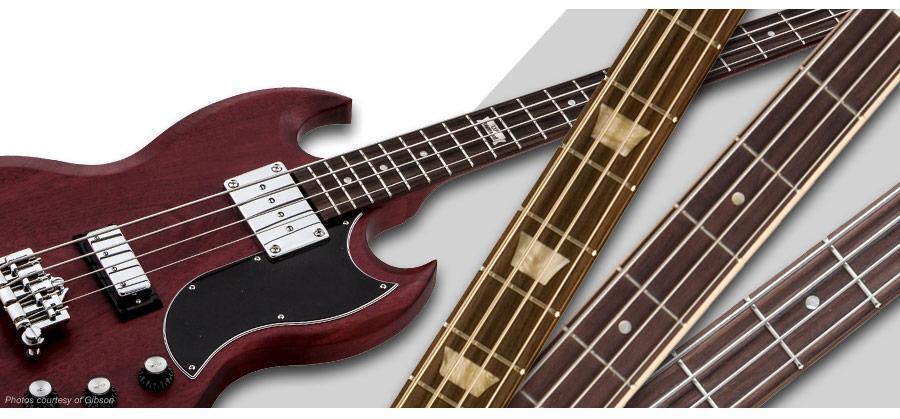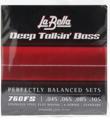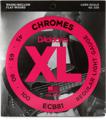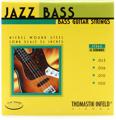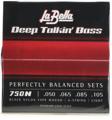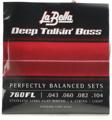The importance of bass strings
Bass guitars are designed to give you deep lows that help drive the music. A bass’s strings can make a big difference in the tone of your bass. Some strings are brighter and deliver a punchier tone that is ideal for rock, country, pop, and more. Other strings are warmer and more subdued, but offer a fuller, fatter bottom end that’s perfect for jazz, reggae, and that old-school rock and Motown sound. Strings are an important part of finding the perfect bass sound. But with so many choices on the market, it can be confusing as to which set you should buy. We’ll examine what strings are made of, their characteristics, and how they differ. Let Sweetwater clear the confusion and help you understand the world of electric bass guitar strings.
String gauges
… a player that says, “I use 105s” means that the gauge of the fourth string is .105.
An important element in both the tone and playability of your bass, string gauge (how “heavy” or “light” your strings are) can make a real difference in your sound. Gauge refers to the thickness of the string. Usually players will refer to the size of the fourth string (the low E in standard tuning) when referencing their gauge preference. For example, a player that says, “I use 105s” means that the gauge of the fourth string is .105.
So how does gauge come into play when you’re choosing strings? Typically, the thicker the string, the more string tension; the more string tension, the harder it will be to fret. Some players have been known to use unusually large strings, but it’s not advisable to jump up to one of these gauges until you’ve played for a while and developed calluses. And it should be noted that switching gauges can cause your bass’s neck to need adjustment due to more or less string tension.
String construction
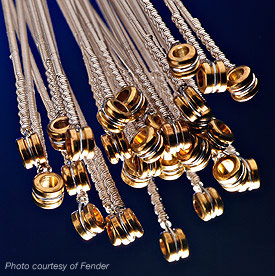
There’s really not a whole lot to a bass string, but all the individual components come together to create the lifeblood of your sound. Running through the middle of the string is a metal core wire. The core wire is affixed to a brass ferrule (commonly called the “ball end”), and the ball end is what typically holds the string on to the bridge. Around the metal core wire is another round wrap wire, which is the part that your fingers press against the fingerboard. All of these pieces combine to produce the type of sound that the different kinds of strings can make. More on that later.
Core
The typical bass string core is made from steel. The core is the center of the string. Windings go around the core to create larger, wound strings. The two basic cores are round and hex. Round cores offer a fatter, vintage-like tone that is balanced and more flexible. Hex cores, the most common type of core, “hold” on to the windings better giving you a brighter sound, more consistent performance, and stiffer tension.

Windings
Bass strings aren’t that different from guitar strings except that they’re bigger. They are available in both nickel/steel or pure steel configurations, and roundwound and flatwound styles are available. Roundwound strings are the most common, used for anything from rock to jazz to country. But in the bass world, flatwounds aren’t uncommon and are found more often than they are in the guitar world. Flatwound strings are great on fretless basses, both sonically and because they cause less wear and tear on the fingerboard. An anomaly in bass strings is the tapewound string, where a nylon wrap is put on the string over the normal roundwound wrap, giving the string a shorter decay and more “thud.” Like acoustic and electric strings, coated bass strings are also available.
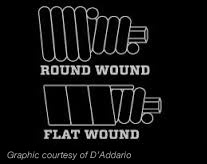
- Roundwound – the most common type, have ridges on the winding
- Half Round – have been ground down to give a smoother feel, warm tone
- Flatwound – reduce finger noise, are smooth to the touch, and have a warm, mellow sound
- Tapewound – nylon outer wrap that gives you a shorter decay and more thud
Materials
A nickel/steel alloy string has a slightly more subdued sound than a pure steel string, with steel typically being brighter.
The two main types of electric bass strings have windings made from nickel/steel alloy or pure stainless steel. A nickel/steel alloy string has a slightly more subdued sound than a pure steel string, with steel typically being brighter. These metals are used for electric bass strings because the metals are ferromagnetic, which means that their vibrations will be detected and transmitted by a magnetic pickup. In recent years, some manufacturers have begun making strings from cobalt and other materials, which reportedly provide more output and clarity than a nickel/steel or pure steel strings.
- Steel – very bright tone
- Nickel/Steel Alloy – bright tone
- Pure Nickel – warmer, broken-in sound
Coating

Coated strings are also available, which simply means that a super-thin coat is applied to the string to help prevent corrosion from sweat and oils. Coated strings tend to last much longer than uncoated strings but are also more expensive.
- Coated Strings – are resistant to corrosion and last longer
Scale Length
Scale length refers to the relationship between the length and diameter (“gauge”) of the strings and the pitches they produce.
Scale length refers to the relationship between the length and diameter (“gauge”) of the strings and the pitches they produce. Short-scale basses are generally defined as having scale lengths between 30′ and 32′. Long-scale basses conventionally have a 34′ string length. Remember that we are talking about string length – the distance between the bridge and the nut – not neck length, although one affects the other.
The first and most obvious reason to use a short-scale bass is physical size. With their shorter necks, less distance between frets, and more compact general dimensions, short-scale basses are a good choice for young players and anyone challenged by the extra reach a long scale instrument requires.
However, many studio pros have long known a secret about the sound of short-scale basses. The shorter strings demand lower string tension to be properly tuned. This gives the strings a kind of soft and floppy feeling, but it also creates fatter, “blooming” low notes and what musicians perceive as sweet upper notes.
- Short Scale = 30-31 inches
- Medium Scale = 32-33 inches
- Long Scale = 34-35 inches (most basses are long scale)
- Extra Long Scale = 35-36+ inches
How often should I change my strings?
If a bright, glossy “zing” is what you’re after, then you’ll probably change strings more often.
This is a question with a different answer for almost every bass player. Some players find that once or twice a month is often enough, while others may go a year or more without requiring a change of strings. While on tour, many bass players will change strings every day! It ultimately depends a lot on the individual’s preferences. If a bright, glossy “zing” is what you’re after, then you’ll probably change strings more often. If you typically set the tone control on your bass guitar or amp to dial out the high end, or “darken” your tone, then you’ll probably need to change less often. Each bass player produces salts, acids, oils, and a wide variety of other chemicals normally released in sweat, so if you’re frequently playing onstage in hot clubs or halls, then you’ll probably have to change strings more often than someone who only plays in a studio environment. Veteran players always wipe down the fingerboard well with a dry cloth after every gig to help extend their string life, and they always carry several sets of new strings with them.
What to look for
Determine if you need to change strings
Are your strings in need of changing? If they look dirty or rusty, change them. If they sound dull, it’s time to change them as well.
What kind of strings?
Try out nickel and steel strings on your bass and notice the sonic differences. Also give coated strings a shot and see if you appreciate the feel and the extra longevity they provide. The best suggestion we can offer is to try different types of strings and see what you like the best.
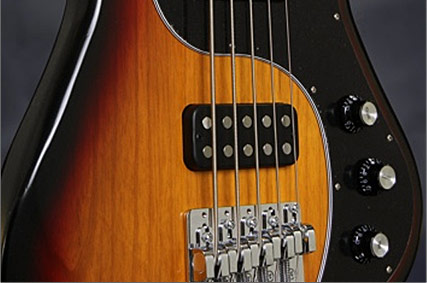
Gauge?
Lighter gauge strings are easier on your fingers, which is especially important for newer players. If you’re going to move up to heavier gauge strings, be prepared that you might need to adjust your action to compensate for string tension.
For more information about bass guitar strings, just give your Sweetwater Sales Engineer a call at (800) 222-4700 !
Check Out These Great Products
-
La Bella 760FS Deep Talkin' Bass Flatwound Bass Guitar Strings - .045-.105 Standard .045-.105 Flatwound Hand-polished Stainless Steel 4-string Bass Strings, Standard Long Scale La Bella's Flatwound Deep Talkin' Bass strings became a top choice for professional...
More Info...- Sale Price: $45.95
- List Price:
$88.00
- + Free Shipping
- + Free Sweetwater Support
-
D'Addario ECB81 Chromes Flatwound Bass Guitar Strings - .045-.100 Light Long Scale .045 - .100 4-string Flatwound Bass Strings, Long Scale, Light Gauge
More Info...- Sale Price: $44.99
- List Price:
$93.55
- + Free Shipping
- + Free Sweetwater Support
-
Thomastik-Infeld JF344 Jazz Flatwound Bass Guitar Strings - .043-.100 Long Scale .043 - .100 Nickel-wound Flatwound Electric Bass String Set
More Info...- Sale Price: $83.95
- List Price:
$165.95
- + Free Shipping
- + Free Sweetwater Support
-
Elixir Strings 14202 Nanoweb Electric Bass Guitar Strings - .045-.130 Light Long Scale, 5-string .045-.130 5-string Nanoweb Light Gauge Electric Bass Strings, Long Scale Elixir's Nanoweb Bass Strings are the perfect string for anyone who likes the punch of an uncoated string but the...
More Info... -
D'Addario NYXL45130 Nickel Wound Bass Guitar Strings - .045-.130 Regular Light, Long Scale, 5-string .045-.130 Regular Light Gauge 5-string Bass Guitar Strings, Nickel Wound over Steel Core D'Addario's NYXL Bass Strings aim to deliver exceptional dynamic range and wide harmonic response. Their recipe is NYXL nickel-plated wrap wire around their NY Steel...
More Info...- Sale Price: $34.99
- List Price:
$67.00
- + Free Shipping
- + Free Sweetwater Support
-
La Bella 750N Deep Talkin' Bass Black Nylon Tapewound Bass Guitar Strings - .050-.105, Light .050 - .105 Black Nylon Tapewound Stainless Steel 4-string Bass Strings, Standard Long Scale Glide effortlessly from note to note with a set of La Bella Black Nylon Tape Deep Talkin' Bass strings. These premium tapewound bass strings...
More Info...- Sale Price: $49.95
- List Price:
$116.90
- + Free Shipping
- + Free Sweetwater Support
-
La Bella 767-6F Deep Talkin' Bass Flatwound VI Strings - .026-.095 .026 - .095 Stainless Steel, Flatwound Bass VI Strings La Bella 767-6F Bass VI strings are tailor-made for your instrument, with the perfect level of taper by their small ball ends and slimmer post sections. These stainless steel,...
More Info...- Sale Price: $52.99
- List Price:
$131.50
- + Free Shipping
- + Free Sweetwater Support
-
La Bella 760FL Deep Talkin' Bass Flatwound Bass Guitar Strings - .043-.104 Light .043-.104 Flatwound Hand-polished Stainless Steel Bass Strings, Standard Long Scale La Bella's Flatwound Deep Talkin' Bass strings became a top choice for professional bass players way back in the 1950s, and their popularity has...
More Info...- Sale Price: $45.95
- List Price:
$88.00
- + Free Shipping
- + Free Sweetwater Support
-
La Bella 760FS-TB Deep Talkin' Bass Flatwound Bass Guitar Strings - .045-.105 Standard Through Body .045-.105 Flatwound Hand-polished Stainless Steel 4-string Bass Strings, Designed for Through-body Bridge Systems
More Info...- Sale Price: $45.95
- List Price:
$88.00
- + Free Shipping
- + Free Sweetwater Support
-
Rotosound RS77LD Jazz 77 Monel Flatwound Bass Guitar Strings - .045-.105 Standard, Long Scale .045-.105 Bass Guitar Strings, Flatwound Flat-wound Rotosound Jazz Bass 77 have been highly praised by Bass Player Magazine as their favorite flat-wound. They are made of stainless steel undercovers and a Monel 400...
More Info...- Sale Price: $44.95
- List Price:
$71.95
- + Free Shipping
- + Free Sweetwater Support
-
Elixir Strings 14077 Nanoweb Electric Bass Guitar Strings - .045-.105 Light/Medium, Long Scale .045-.105 Nanoweb Medium Gauge Electric Bass Strings, Long Scale Elixir's Nanoweb Bass Strings are the perfect string for anyone who likes the punch of an uncoated...
More Info... -
Ernie Ball Regular Slinky Bass Bundle - .050-.105 (2-pack) .050 - .105 Custom Gauge Electric Bass Guitar Strings, Regular Slinky - 2-pack Ernie Ball strings have been a top choice for players of all types since the early 1960s,...
More Info...- Sale Price: $39.98
- List Price:
$79.20
- + Free Shipping
- + Free Sweetwater Support
Inspiration. Information. Passion.
Being music makers ourselves, we love geeking out on all things gear. From the tweakiest techniques to the biggest ideas, our experts work hard to constantly supply inSync with a steady stream of helpful, in-depth demos, reviews, how-tos, news, and interviews. With over 28,000 articles and counting, inSync is your FREE resource for breaking news, reviews, demos, interviews, and more.


